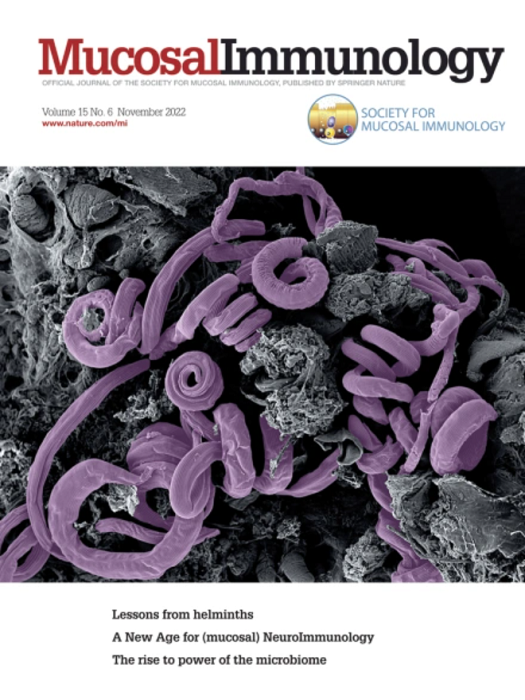TRIM29 controls enteric RNA virus-induced intestinal inflammation by targeting NLRP6 and NLRP9b signaling pathways
IF 7.6
2区 医学
Q1 IMMUNOLOGY
引用次数: 0
Abstract
Infections by enteric virus and intestinal inflammation are recognized as a leading cause of deadly gastroenteritis, and NLRP6 and NLRP9b signaling control these infection and inflammation. However, the regulatory mechanisms of the NLRP6 and NLRP9b signaling in enteric viral infection remain unexplored. In this study, we found that the E3 ligase TRIM29 suppressed type III interferon (IFN-λ) and interleukin-18 (IL-18) production by intestinal epithelial cells (IECs) when exposed to polyinosinic:polycytidylic acid (poly I:C) and enteric RNA viruses. Knockout of TRIM29 in IECs was efficient to restrict intestinal inflammation triggered by the enteric RNA viruses, rotavirus in suckling mice, and the encephalomyocarditis virus (EMCV) in adults. This attenuation in inflammation was attributed to the increased production of IFN-λ and IL-18 in the IECs and more recruitment of intraepithelial protective Ly6A+CCR9+CD4+ T cells in small intestines from TRIM29-deficient mice. Mechanistically, TRIM29 promoted K48-linked ubiquitination, leading to the degradation of NLRP6 and NLRP9b, resulting in decreased IFN-λ and IL-18 secretion by IECs. Our findings reveal that enteric viruses utilize TRIM29 to inhibit IFN-λ and inflammasome activation in IECs, thereby facilitating viral-induced intestinal inflammation. This indicates that targeting TRIM29 could offer a promising therapeutic strategy for alleviating gut diseases.

TRIM29 通过靶向 NLRP6 和 NLRP9b 信号通路控制肠道 RNA 病毒诱导的肠道炎症。
肠道病毒感染和肠道炎症被认为是致命性肠胃炎的主要原因,而 NLRP6 和 NLRP9b 信号传导控制着这些感染和炎症。然而,NLRP6 和 NLRP9b 信号在肠道病毒感染中的调控机制仍有待探索。在这项研究中,我们发现当肠道上皮细胞(IECs)暴露于多聚肌苷酸:多聚胞苷酸(poly I:C)和肠道RNA病毒时,E3连接酶TRIM29会抑制III型干扰素(IFN-λ)和白细胞介素-18(IL-18)的产生。在 IECs 中敲除 TRIM29 能有效限制肠道 RNA 病毒、乳鼠轮状病毒和成人脑心肌炎病毒(EMCV)引发的肠道炎症。炎症的减轻归因于 IECs 中 IFN-λ 和 IL-18 的产生增加,以及 TRIM29 缺失小鼠小肠中上皮内保护性 Ly6A+CCR9+CD4+ T 细胞的招募增加。从机理上讲,TRIM29促进了与K48相连的泛素化,导致NLRP6和NLRP9b降解,从而使IECs分泌的IFN-λ和IL-18减少。我们的研究结果表明,肠道病毒利用 TRIM29 抑制 IFN-λ 和 IECs 中炎性体的激活,从而促进病毒诱导的肠道炎症。这表明,靶向 TRIM29 可为缓解肠道疾病提供一种前景广阔的治疗策略。
本文章由计算机程序翻译,如有差异,请以英文原文为准。
求助全文
约1分钟内获得全文
求助全文
来源期刊

Mucosal Immunology
医学-免疫学
CiteScore
16.60
自引率
3.80%
发文量
100
审稿时长
12 days
期刊介绍:
Mucosal Immunology, the official publication of the Society of Mucosal Immunology (SMI), serves as a forum for both basic and clinical scientists to discuss immunity and inflammation involving mucosal tissues. It covers gastrointestinal, pulmonary, nasopharyngeal, oral, ocular, and genitourinary immunology through original research articles, scholarly reviews, commentaries, editorials, and letters. The journal gives equal consideration to basic, translational, and clinical studies and also serves as a primary communication channel for the SMI governing board and its members, featuring society news, meeting announcements, policy discussions, and job/training opportunities advertisements.
 求助内容:
求助内容: 应助结果提醒方式:
应助结果提醒方式:


